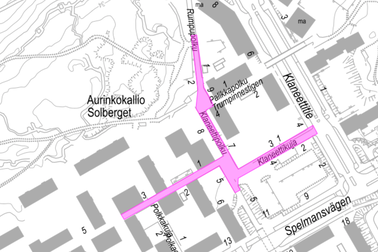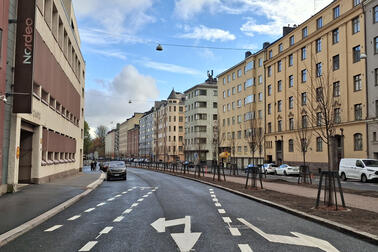
The Esplanadi experiment will undergo a wide range of monitoring throughout the two-year period. At the end of October, the City published results on the social impact of the experiment, as well as its effects on vitality, maintenance traffic and air quality. Now they have results on traffic volumes and the opinions of residents. The Urban Environment Committee will discuss the monitoring results at its meeting on Tuesday 5 December 2023.
Number of pedestrians has increased
Traffic volumes on the Esplanadi streets and summer streets were measured before and after the start of the experiment. The monitoring covered motor traffic, cycling and pedestrian traffic. The number of pedestrians in the area has increased since the start of the experiment in June compared to the spring counts. Pedestrian volumes increased by around 30–60% on Pohjoisesplanadi and 80–200% on the summer street in front of the Design Museum.
“We are still unable to say how the experiment itself has influenced the increase in pedestrian numbers and how much of it is due to seasonal variations or the number of tourists, for example. We will gain more insight into the impact of the experiment on pedestrian volumes as we continue the experiment,” says Reetta Putkonen, Head of Traffic and Street Planning.
The studies found no significant changes in cycling volumes since the start of the experiment.
Motor traffic volumes have remained unchanged on the Esplanadi streets but increased on Kaivokatu
Since the start of the experiment, motor traffic volumes have remained practically unchanged on both Esplanadi streets. Since the start of the experiment, motor traffic has shifted most to Kaivokatu, where it has increased by about a third compared to the initial situation in March–April. The increase in traffic on Kaivokatu cannot be explained by the Esplanadi experiment alone. The results must be considered in light of the fact that the renovation of Mannerheimintie, which started in March, decreased the traffic volumes on Kaivokatu during the reference period. In August 2023, after the start of the experiment, the average daily traffic volume on Kaivokatu was 2,000 vehicles less than in previous years, excluding 2020 and 2021.
Traffic volumes have also increased on Tehtaankatu and Liisankatu. There have been no changes in the smoothness of motor traffic on these street sections. The experiment has not led to any substantial shift of motor traffic to the local street network of Kaartinkaupunki. Traffic volumes have decreased significantly on the Kasarmikatu summer street, and there was less traffic on Pohjoinen Makasiinikatu in July but slightly more in August compared to the baseline.
Motor traffic is slightly less smooth, but changes are localised
Based on the review, the experiment has caused motor traffic to flow less smoothly on the Esplanadi streets, but the spillover effects on the rest of the street network have been moderate and localised. These effects were mainly observed in Pohjoisranta and on Kaivokatu. The shifts of motor traffic have caused no significant disruption to traffic flow on the streets where the traffic has moved to. Travel times by car on routes through the city centre have increased by an average of around 10% since the start of the experiment. During peak periods, the increase in travel times is typically in the order of 1–3 minutes, and 0–1 minutes during daytime. In addition to the Esplanadi experiment, street works in the city centre have also contributed to the increase in travel times.
Opinions are divided on the Esplanadi experiment – younger age groups and car-free people are more in favour than older age groups and car owners
To monitor the experiment, a survey was carried out in which 1,250 Helsinki residents were interviewed by telephone, ensuring that the sample was statistically representative by age, gender and car ownership. An even sample of respondents from the inner city and suburbs were included in the survey. The sample consists of Helsinki residents aged 18–80. To be eligible for the survey, the respondent needed to have visited the Esplanadi area after the start of the experiment on 12 June 2023.
Respondents’ opinions were divided on the permanent measures to improve the pedestrian environment on the Esplanadi streets. A slim majority (51%) felt that the pedestrian environment should be improved, even if it meant reducing the number of car lanes, whereas 44% of respondents were against this. The younger the respondent, the more likely they were to be in favour of the measures (68% in the 18–29 age group and 55% in the 30–44 age group). Car-free people (62%) and women (55%) were also slightly more in favour of the measures. Among car-owning households, support for the permanent solutions was 38%.
According to the survey, by far the most common mode of transport on the Esplanadi streets during the experiment has been walking (93%). Just under a third have travelled in the area by car and just under a quarter by bicycle. Furthermore, 9% of respondents have travelled by taxi and 5% by electric scooter. The majority of respondents arrived in the city centre by public transport (61%) on their last visit to the Esplanadi streets. Respondents who arrived on foot or by car accounted for 14% each. Just under a tenth arrived by bicycle.
Those who walked on the Esplanadi streets during the experiment felt that walking was very smooth (4.07 on a scale of 1 to 5). The majority of cyclists also felt that moving around was smooth (3.57). In contrast, people travelling by car found it difficult to move around (2.20). A significant majority (76%) of those who are dissatisfied with the smoothness of car travel feel that this is a major problem.
Respondents also rated the pleasantness of the area on a scale of 1 to 5, with 5 being the most pleasant. All areas covered by the experiment scored well above 3 on average and most scored above 3.5. The Design Museum Square has been perceived as the most pleasant area. Pohjoisesplanadi was perceived as more pleasant than Eteläesplanadi.
Monitoring is also carried out during the winter season
The Esplanadi experiment will continue until the end of 2024, and monitoring will continue throughout the experiment. During the winter season, the monitoring will cover traffic volumes, the smoothness of motor traffic, vitality effects and observations of the use of the experiment area during the winter season. The co-planning workshops and residents’ panel will also continue next year. As the Lönnrotinkatu bicycle lane was only completed at the end of August, more detailed information on its impact will not be available until next year. The results of the winter season will be presented to the Urban Environment Committee in late spring 2024.


